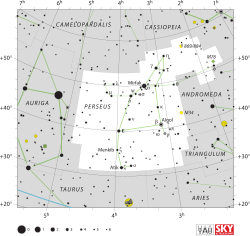34 Persei
| 34 Persei | |
 | |
| Observationsdata Epok: J2000.0 | |
|---|---|
| Stjärnbild | Perseus |
| Rektascension | 03t 29m 22,05019s[1] |
| Deklination | +49° 30′ 32,2114″[2] |
| Skenbar magnitud () | +4,67[3] (4,76 + 7,18)[4], +4,735 ± 0,009 (V)[2] |
| Stjärntyp | |
| Spektraltyp | B3 V[5], |
| U–B | -0,57[6] |
| B–V | -0,096 ± 0,003[7] |
| Astrometri | |
| Radialhastighet () | -3,50 ± 0,9[8] km/s |
| Egenrörelse (µ) | RA: 22,10 ± 0,35[1] mas/år Dek.: -29,49 ± 0,35[1] mas/år |
| Parallax () | 6,05 ± 0,36[1] |
| Avstånd | 540 ± 30 lå (165 ± 10 pc) |
| Absolut magnitud () | -1,62[3] |
| Detaljer | |
| Massa | 6,9 ± 0,1[9] M☉ |
| Radie | 3,1[10] R☉ |
| Luminositet | 671[3] L☉ |
| Temperatur | 16 421[11] K |
| Vinkelhastighet | 200[11] km/s |
| Ålder | 29,3 ± 3,4[9] miljoner år |
| Andra beteckningar | |
| CCDM J03294+4931AB, GCRV 1910, IRAS 03257+4920, TD1 2204, GEN# +5.20200835J, JP11 4568, TYC 3320-2810-1, BU 1179AB, GSC 03320-02810, 2MASS J03292205+4930322, UBV 3317, ADS 2558 AB, HD 21428, PLX 719, UBV M 40931, AG+49 416, HGAM 226, PLX 719.00, uvby98 520200835, ALS 16804, HIC 16244, PPM 46235, WDS J03294+4931AB, BD+49 945, HIP 16244, ROT 496, WEB 3097, Melotte 20 835, HR 1044, SAO 38872, YPAC 92, GC 4133, IDS 03222+4910 AB, SKY# 5252[2] | |
34 Persei, som är stjärnans Flamsteed-beteckning, är en dubbelstjärna[4] belägen i den norra delen av stjärnbilden, Perseus. Den har en kombinerad skenbar magnitud på ca 4,67[3] och är svagt synlig för blotta ögat där ljusföroreningar ej förekommer. Baserat på parallaxmätning inom Hipparcosuppdraget på ca 6,1[1] mas, beräknas den befinna sig på ett avstånd på ca 540 ljusår (ca 165 parsek) från solen. Den rör sig närmare solen med en heliocentrisk radialhastighet av ca –3,5 km/s.[6] Stjärnan ingår i Alfa Persei-hopen.[12]
Egenskaper
Primärstjärnan 34 Persei A är en blå till vit stjärna i huvudserien av spektralklass B3 V.[5] Den har en massa som är ca 7[9] solmassor, en radie som är ca 3[10] solradier och utsänder ca 671[3] gånger mera energi än solen från dess fotosfär vid en effektiv temperatur på ca 16 400 K.[8]
Följeslagaren 34 Persei B är separerad med 0,6 bågsekunder och är av magnitud 7,34.[13]
Referenser
- Den här artikeln är helt eller delvis baserad på material från engelskspråkiga Wikipedia, 34 Persei, 1 augusti 2020.
Noter
- ^ [a b c d e] Van Leeuwen, F. (2007). "Validation of the new Hipparcos reduction". Astronomy and Astrophysics. 474 (2): 653. arXiv:0708.1752. Bibcode:2007A&A...474..653V. doi:10.1051/0004-6361:20078357. Vizier catalog entry
- ^ [a b c] ”Basic data: * 34 Per –Double or multiple star” (på engelska). Centre de Données astronomiques de Strasbourg. http://simbad.u-strasbg.fr/simbad/sim-basic?Ident=34+Per&submit=SIMBAD+search. Läst 27 februari 2019.
- ^ [a b c d e] Anderson, E.; Francis, Ch. (2012). "XHIP: An extended hipparcos compilation". Astronomy Letters. 38 (5): 331. arXiv:1108.4971. Bibcode:2012AstL...38..331A. doi:10.1134/S1063773712050015. Vizier catalog entry
- ^ [a b] Eggleton, P. P.; Tokovinin, A. A. (September 2008). "A catalogue of multiplicity among bright stellar systems". Monthly Notices of the Royal Astronomical Society. 389 (2): 869–879. arXiv:0806.2878. Bibcode:2008MNRAS.389..869E. doi:10.1111/j.1365-2966.2008.13596.x.
- ^ [a b] Hoffleit, D.; Warren, W. H. (1995). "Bright Star Catalogue". VizieR On-line Data Catalog: V/50. Originally Published in: 1964BS....C......0H (5th Revised ed.). 5050. Bibcode:1995yCat.5050....0H.
- ^ [a b] Mallama, A. (2014). "Sloan Magnitudes for the Brightest Stars". The Journal of the American Association of Variable Star Observers. 42: 443. Bibcode:2014JAVSO..42..443M.Vizier catalog entry
- ^ van Leeuwen (2007). ”Hipparcos, the New Reduction” (på engelska). http://vizier.u-strasbg.fr/viz-bin/VizieR-5?-out.add=.&-source=I/311/hip2&HIP=16244. Läst 27 februari 2019.
- ^ [a b] Gontcharov, G. A. (2006). "Pulkovo Compilation of Radial Velocities for 35 495 Hipparcos stars in a common system". Astronomy Letters. 32 (11): 759. arXiv:1606.08053. Bibcode:2006AstL...32..759G. doi:10.1134/S1063773706110065.
- ^ [a b c] Tetzlaff, N.; et al. (January 2011). "A catalogue of young runaway Hipparcos stars within 3 kpc from the Sun". Monthly Notices of the Royal Astronomical Society. 410 (1): 190–200. arXiv:1007.4883. Bibcode:2011MNRAS.410..190T. doi:10.1111/j.1365-2966.2010.17434.x.
- ^ [a b] Pasinetti Fracassini, L. E.; et al. (February 2001), "Catalogue of Apparent Diameters and Absolute Radii of Stars (CADARS)", Astronomy and Astrophysics (Third ed.), 367 (2): 521–524, arXiv:astro-ph/0012289, Bibcode:2001A&A...367..521P, doi:10.1051/0004-6361:20000451
- ^ [a b] David, Trevor J.; Hillenbrand, Lynne A. (2015). "The Ages of Early-Type Stars: Strömgren Photometric Methods Calibrated, Validated, Tested, and Applied to Hosts and Prospective Hosts of Directly Imaged Exoplanets". The Astrophysical Journal. 804 (2): 146. arXiv:1501.03154. Bibcode:2015ApJ...804..146D. doi:10.1088/0004-637X/804/2/146.
- ^ Hoogerwerf, Ronnie (mars 2000). ”OB association members in the ACT and TRC catalogues” (på engelska). Monthly Notices of the Royal Astronomical Society 313 (1): sid. 43−65. doi:.
- ^ Mason, Brian D.; Wycoff, Gary L.; Hartkopf, William I.; Douglass, Geoffrey G.; Worley, Charles E. (2001). ”The 2001 US Naval Observatory Double Star CD-ROM. I. The Washington Double Star Catalog” (på engelska). The Astronomical Journal 122 (6): sid. 3466. doi:.
| |||||||||||||||||||
Media som används på denna webbplats
Författare/Upphovsman: IAU and Sky & Telescope magazine (Roger Sinnott & Rick Fienberg), Licens: CC BY 3.0
IAU Perseus chart


